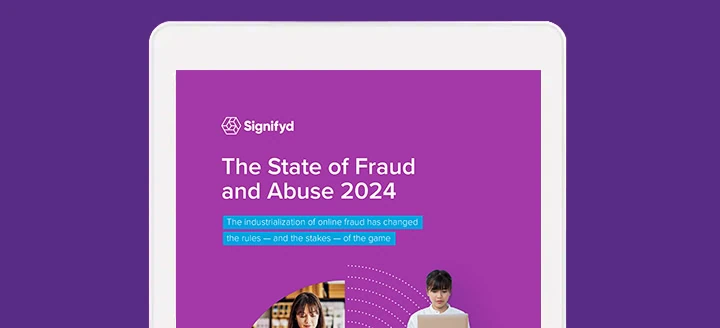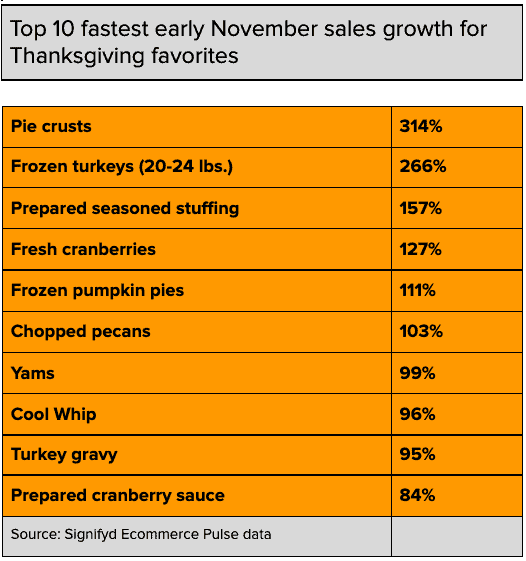This Thanksgiving, chances are it won’t be your Uncle Darnell or your Aunt Sofia arriving at your door with the pumpkin pie. It will be a delivery driver from Instacart, DoorDash, Safeway or Albertsons, bringing the dessert and just about everything else you need for the traditional feast.
Or it might be that you bring it yourself, after pulling up to the curb at your favorite supermarket and waiting for a store associate to load in the turkey, stuffing, sweet potatoes, green beans, whip cream, cranberry sauce, libations and whatever else makes your meal, your meal.
Think of Thanksgiving 2021 as the first Thanksgiving of the online grocery era. The COVID-19 pandemic has moved grocery shopping online and to the curbside in a massive way. And while ecommerce grocery shopping was in full force during Thanksgiving 2020, that one doesn’t count. Few celebrated a traditional Thanksgiving last year with big feasts and big gatherings.
Online grocery shopping is the new grocery shopping
So, it’s safe to say that between our last “normal” Thanksgiving in 2019 and this year’s celebration, grocery shopping (and selling) has undergone a complete makeover.
- Online grocery sales were up 108% in 2020, according to Digital Commerce 360.
- In 2020 alone the percentage of Digital 360 Top 500 Retailers offering curbside pickup increased from 6.6% to 50.7%. The Top 500 includes the largest grocery sellers in the country.
- Consumers embraced online grocery shopping and for reasons beyond avoiding contagion during a pandemic. Sixty-one percent told Digital Commerce 360 they shopped for groceries online to save time; 57% said it allows them to shop when they want to and 46% said it allows them to avoid long lines.
- With online grocery shopping now a thing, ecommerce fraud has followed. Some grocers are for the first time finding themselves wrestling with online fraud and the financial liability and customer experience challenges that come with it.
These are not short-term trends. As of last week, online grocery sales were 76% higher than the same pre-pandemic week in 2019, according to Signifyd Ecommerce Pulse data.
And when it comes to shopping for Thanksgiving dinner in particular, well, let’s just say the trend is holding. The hottest selling grocery item last week? Pie crusts, with online sales up 314% last week, compared to the week before, according to a relevant subset of Signifyd data.
Other big online sellers likely headed for Thanksgiving tables? Yep. Frozen turkeys, which saw a sales boost of 164% between the first and second week of November. And if you like turkey, you’re in luck. Sales of the biggest birds, turkeys weighing between 20 and 24 pounds, increased by 266%. Sounds like a recipe for leftovers.
Ecommerce sales of Thanksgiving dinner staples have doubled
Then there were frozen pumpkin pies, for those who didn’t want to fool with filling the crusts. Sales of the heat-and-eat pies saw a 111% rise. Fresh cranberries were up 127%, for those of you who like homemade cranberry sauce. Stuffing shot up 91%; yams saw a 99% increase (sorry kids), prepared turkey gravy was up 95% and Cool Whip climbed 96%. Climbed — more than we can say for some who will finish off the feast.
While pie crust and turkey sales may cool off after the holidays, industry experts do not expect online grocery shopping to follow — either after the holidays or when COVID is declared conquered. Usman Humayu, vice president of digital marketing at grocery chain operator Albertsons Cos. Inc., laid it out for Digital Commerce 360.
“Both digital engagement and ordering remains strong with customers,” he told the retail news outlet. “While the pandemic allowed for rapid acceleration of both development and adoption of digital for groceries, we are seeing stickiness in customer behavior, especially when they are presented with the right experience and content on digital platforms.”
As more grocery shopping moves online, retailers are facing a challenge that was barely on their radar, even three years ago when the share of online grocery shopping hovered around 3.5%. Fraud. Overall, Signifyd data shows ecommerce fraud pressure is up over 370% since January 2020, considered the pre-pandemic benchmark.
Where online sales go, fraud follows
In grocery, specifically during the Thanksgiving runup, the number of orders arriving with enough red flags to be considered fraudulent was up by 29% last week over the previous week.
We know. Sounds strange. What items in the grocery aisle are online fraudsters after? Are they buying up Fruit Loops with other people’s financial information in order to resell them? Are they finding ill-gotten gains in sugar, flour, spices? Purloined sirloin?
The first thing to remember is that online fraud is new for many in the grocery industry, because online commerce as a substantial sales channel is new. Fraud rings understand that grocers’ detection and defenses might not have caught up to the fraudsters’ tactics. And so they attack.
And grocery stores carry much more than cereal and spices. Think liquor, disposable diapers, baby formula and other pricey items for which most consumers have a good sense of a fair price. If a fraudster can essentially steal those items, by having them delivered or picking them up at the curb (never having to leave the getaway car), they can sell them at a substantial discount. That makes for a nefarious business model that works.
Lynn Schiess, Signifyd senior lead risk analyst, says three prominent fraud personas are emerging in the early going of online grocery fraud. First, there’s the hunter/gatherer.
“I’m a fraudster with a stolen credit card and I just don’t want to pay for my own groceries,’’ Schiess explains. “So, just like stealing high-end electronics, I steal groceries for myself. Maybe times are tough. I’m out of work.”
Then there is the profiteer that goes after items that are more obvious targets of fraud.
“They just want three bottles of tequila or 10 cases of beer,” she says. “Those are easy to spot.”
Is purloined sirloin the latest fraud trend?
And there is a variation of the profiteer. Think, the human wholesaler, who goes after commodities and products primed for business-to-business deals.
“We started seeing other things,” Schiess says, “like the big bulk toilet paper, paper towels, meat products, shrimp, diapers, baby formula.”
So maybe purloined sirloin is a thing. But what does a fraud ring do with perishable food?
“Maybe they were intent on selling them to restaurants at a discount,” Schiess speculates. “Restaurants were hit hard in the pandemic. A mom and pop restaurant, maybe they’re willing to kind of buy stuff from out the back door with Johnny pulling up in the van.”
The good news for grocery retailers is that they can learn from those who have gone before them. Some of the largest grocery sellers have turned to Signifyd’s Commerce Protection Platform, which uses machine learning and a vast Commerce Network to provide insights into the identity and intent behind every order.
Using advanced technology to protect a commerce enterprise from fraud while making sure that loyal customers aren’t prevented from buying the groceries they want is the way successful grocers are taking control of their new sales channels.
It’s a recipe that means that for those merchants, the first Thanksgiving of the online grocery era will be a memorable one — for all the right reasons.
Signifyd Data Analyst Phelim Killough contributed to this report. Photo by Getty Images
Working to protect the enterprise from fraud as you scale up? We can help.













